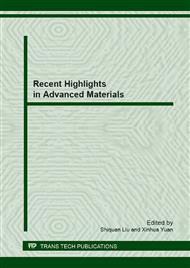[1]
J.Y. Lee, O.K. Farha, J. Roberts, K.A. Scheidt, S.T. Nguyen, J.T. Hupp, Metal-organic framework materials as catalysts, Chem. Soc. Rev. 38 (2009) 1450-1459.
DOI: 10.1039/b807080f
Google Scholar
[2]
V. Finsy, H. Verelst, L. Alaerts, D. De. Vos, P.A. Jacobs, G.V. Baron, J.F.M. Denayer, Pore-filling-dependent selectivity effects in the vapor-phase separation of xylene isomers on metal-organic framework MIL-47, J. Am. Chem. Soc. 130 (2008).
DOI: 10.1021/ja800686c
Google Scholar
[3]
Z. Guo, R. Cao, X. Wang, H. Li, W. Yuan, G. Wang, H. Wu, J. Li, A multifunctional 3D ferroelectric and NLO-active porous metal-organic framework, J. Am. Chem. Soc. 131 (2009) 6894-6895.
DOI: 10.1021/ja9000129
Google Scholar
[4]
B. Wang, A.P. Cote, H. Furukawa, M. O'Keeffe, O.M. Yaghi, Colossal cages in zeolitic imidazolate frameworks as selective carbon dioxide reservoirs, Nature 453 (2008) 207-211.
DOI: 10.1038/nature06900
Google Scholar
[5]
B. Kesanli, Y. Cui, M.R. Smith, E.W. Bittner, B.C. Bockrath, W. -B. Lin, Highly interpenetrated metal-organic frameworks for hydrogen storage, Angew. Chem. Int. Ed. 44 (2005) 72-75.
DOI: 10.1002/anie.200461214
Google Scholar
[6]
M. Mueller, X. Zhang, Y.M. Wang, R.A. Fischer, Nanometer-sized titania hosted inside MOF-5, Chem. Commun. (1) (2009) 119-121.
DOI: 10.1039/b814241f
Google Scholar
[7]
R.K. Bhakta, J.L. Herberg, B. Jacobs, A. Highley, R. Behrens, Jr., N.W. Ockwig, J.A. Greathouse, M.D. Allendorf, Metal-organic frameworks as templates for nanoscale NaAlH4, J. Am. Chem. Soc. 131 (2009) 13198-13199.
DOI: 10.1021/ja904431x
Google Scholar
[8]
S.R. Halper, L. Do, J.R. Stork, S.M. Cohen, Topological control in heterometallic metal-organic frameworks by anion templating and metalloligand design, J. Am. Chem. Soc. 128 (2006) 15255-15268.
DOI: 10.1021/ja0645483
Google Scholar
[9]
R.S. Crees, M.L. Cole, L.R. Hanton, C.J. Sumby, Synthesis of a Zinc(II) imidazolium dicarboxylate ligand metal-organic framework (MOF): a potential precursor to MOF-tethered N-heterocyclic carbene compounds, Inorg. Chem. 49 (2010) 1712-1719.
DOI: 10.1021/ic9021118
Google Scholar
[10]
J.F. Eubank, L. Wojtas, M.R. Hight, T. Bousquet, V. Ch. Kravtsov, M. Eddaoudi, The next chapter in MOF pillaring strategies: trigonal heterofunctional ligands to access targeted high-connected three dimensional nets, isoreticular platforms, J. Am. Chem. Soc. 133 (2011).
DOI: 10.1021/ja203898s
Google Scholar
[11]
Z. Wang, B. Zhang, H. Fujiwara, H. Kobayashi, M. Kurmoo, Mn3(HCOO)6: a 3D porous magnet of diamond framework with nodes of Mn-centered MnMn4 tetrahedron and guest-modulated ordering temperature, Chem. Commun. 4 (2004) 416-417.
DOI: 10.1039/b314221c
Google Scholar
[12]
G. Férey, C Mellot-Draznieks, C. Serre, F. Millange, J. Dutour, S. Surblé, I. Margiolaki, A chromium terephthalate-based solid with unusually large pore volumes and surface area, Science 309 (2005) 2040-(2042).
DOI: 10.1126/science.1116275
Google Scholar
[13]
R. -Q. Zhong, R. -Q. Zou, D.S. Pandey, T. Kiyobayashi, Q. Xu, A novel 3D microporous metal-organic framework of cadmium(II) oxalate with diamondoid network, Inorg. Chem. Commun. 11 (2008) 951-953.
DOI: 10.1016/j.inoche.2008.05.010
Google Scholar
[14]
J. Tao, X. Yin, R. Huang, L. Zheng, S.W. Ng, Assembly of a microporous metal-organic framework [Zn(bpdc)(DMSO)](bpdc = 4, 4'-biphenyldicarboxylate) based on paddle-wheel units affording guest inclusion, Inorg. Chem. Commun. 5 (2002) 975-977.
DOI: 10.1016/s1387-7003(02)00623-8
Google Scholar
[15]
D.J. Tranchemontagne, J.R. Hunt, O.M. Yaghi, Room temperature synthesis of metal-organic frameworks: MOF-5, MOF-74, MOF-177, MOF-199, and IRMOF-0, Tetrahedron 64 (2008) 8553-8557.
DOI: 10.1016/j.tet.2008.06.036
Google Scholar
[16]
H. Li, M. Eddaoudi, M. O'Keeffe, O.M. Yaghi, Design and synthesis of an exceptionally stable and highly porous metal-organic framework, Nature 402 (1999) 276-279.
DOI: 10.1038/46248
Google Scholar
[17]
O.M. Yaghi, C.E. Davis, G. Li, H. Li, Selective guest binding by tailored channels in a 3-D porous zinc(II)-benzenetricarboxylate network, J. Am. Chem. Soc. 119 (1997) 2861-2868.
DOI: 10.1021/ja9639473
Google Scholar
[18]
H.K. Chae, D.Y. Siberio-Perez, J. Kim, Y. Go, M. Eddaoudi, A.J. Matzger, M. O'Keeffe, O.M. Yaghi, A route to high surface area, porosity and inclusion of large molecules in crystals, Nature 427 (2004) 523-527.
DOI: 10.1038/nature02311
Google Scholar
[19]
S. -Y. Yang, L. -S. Long, R. -B. Huang, L. -S. Zheng, S.W. Ng, Poly[bis[(dimethylsulfoxide)zinc(II)]-di-4-benzene-1, 4-dicarboxylato] dimethyl sulfoxide pentasolvate], Acta Cryst. 61 (2005) 1671-1673.
DOI: 10.1107/s1600536805023986
Google Scholar
[20]
H. Li, M. Eddaoudi, T.L. Groy, O.M. Yaghi, Establishing microporosity in open metal-organic frameworks: gas sorption isotherms for Zn(BDC)(BDC=1, 4-Benzenedicarboxylate), J. Am. Chem. Soc. 120 (1998) 8571-8572.
DOI: 10.1021/ja981669x
Google Scholar
[21]
P. Long, Q. Zhao, J. Dong, J. Li, Synthesis of metal-organic frameworks from the system metal/L-glutamic acid/TEA/H2O, J. Coord. Chem. 62 (2009) 1959-(1963).
DOI: 10.1080/00958970902737903
Google Scholar
[22]
A. Thirumurugan, C.N.R. Rao, 1, 2-, 1, 3- and 1, 4-Benzenedicarboxylates of Cd and Zn of different dimensionalities: Process of formation of the three-dimensional structure, J. Mater. Chem. 15 (2005) 3852-3858.
DOI: 10.1039/b504666a
Google Scholar
[23]
I. Mihalcea, N. Henry, T. Bousquet, C. Volkringer, T. Loiseau, Six-fold coordinated uranyl cations in extended coordination polymers, Cryst. Growth Des. 12 (2012) 4641-4648.
DOI: 10.1021/cg300853f
Google Scholar
[24]
B. Paula, B. Zimmermannb, K.M. Frommc, C. Janiaka, [M(μ-O2C-C6H4-CO2)(NH3)2] (M=Cu, Cd; O2C-C6H4-CO2=benzene-1, 4-dicarboxylate, terephthalate): 1D coordination polymers with strong inter-chain hydrogen bonding, Z. Anorg. Allg. Chem. 630 (2004).
DOI: 10.1002/zaac.200400240
Google Scholar
[25]
X. -F. Wang, X. -L. Zhang, X. Zhou, J. Li, Y. -F. Kuang, J. -H. Chen, A copper-carboxylate layer-framework with pseudo-Kagomé net, Z. Anorg. Allg. Chem. 638 (2012) 1365-1369.
DOI: 10.1002/zaac.201200131
Google Scholar
[26]
O.M. Yaghi, H. Li, and T. L. Groy, Construction of porous solids from hydrogen-bonded metal complexes of 1, 3, 5-benzenetricarboxylic acid, J. Am. Chem. Soc. 118 (1996) 9096-9101.
DOI: 10.1021/ja960746q
Google Scholar
[27]
O. Shekhah, H. Wang, T. Strunskus, P. Cyganik, D. Zacher, R. Fischer, C. Woll, Layer-by-layer growth of oriented metal organic polymers on a functionalized organic surface, Langmuir 23 (2007) 7440-7442.
DOI: 10.1021/la701148z
Google Scholar
[28]
M. Edgar, R. Mitchell, A.M.Z. Slawin, P. Lightfoot, P.A. Wright, Solid-state transformation of zinc 1, 4-benzenedicarboxylates mediated by hydrogen-bond-forming molecules, Chem. Eur. J. 7 (2001) 5168-5175.
DOI: 10.1002/1521-3765(20011203)7:23<5168::aid-chem5168>3.0.co;2-s
Google Scholar
[29]
G. M. Sheldrick, SHELXS-97, Program for Structure Solution, University of Göttingen, Germany, (1997).
Google Scholar
[30]
L.L. Wei, J.V. Jagadese, One-dimensional coordination polymers: complexity and diversity in structures, properties, and applications, Chem. Rev. 111 (2011) 688-764.
DOI: 10.1021/cr100160e
Google Scholar


